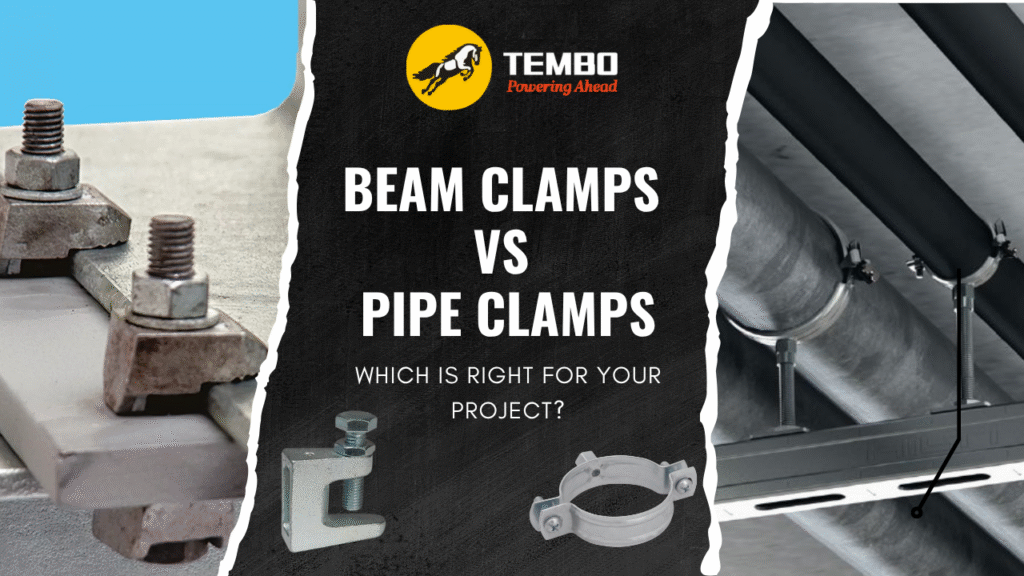
When working on construction, plumbing, or industrial projects, one common challenge is securely fastening structural elements or pipes. Two popular solutions for this are beam clamps and pipe clamps. While they may seem similar at first glance, each serves distinct purposes and offers unique advantages. Choosing between them depends on your specific application, load requirements, and installation conditions.
In this article, we’ll break down the difference between beam clamps and pipe clamps, explore the various pipe clamp types, and help you decide which option is best for your project.
Table of Contents
What is a Beam Clamp?
A beam clamp is a fastening device designed to attach to structural steel beams without drilling or welding. It provides a secure anchor point for hanging threaded rods, equipment, or conduit.
Beam clamps are widely used in construction, HVAC installations, and industrial support systems.
A specialized variant is the lifting beam clamp, which is designed to safely lift and suspend heavy loads in factories, warehouses, or construction sites. These clamps are engineered to distribute weight evenly and minimize structural stress.
Key Advantages of Beam Clamps
- No Drilling Required: They attach directly to the beam, reducing installation time.
- Adjustable and Reusable: Can be repositioned as needed without damaging the beam.
- Strong Load Capacity: Perfect for suspending heavy machinery or ductwork.
- Compatibility with Threaded Rods: Many models are designed to hold a beam clamp threaded rod for added stability in suspended systems.
What is a Pipe Clamp?
A pipe clamp is a fastening device used to hold pipes securely against walls, ceilings, or structural beams. Unlike beam clamps, which focus on structural anchoring, pipe clamps are designed specifically for pipe support and alignment.
Pipe clamps come in various designs, such as U pipe clamps, pipe clamp brackets, hose pipe clamps, and other pipe clamp types. Each type caters to different applications—from plumbing to industrial fluid transport.
Common Types of Pipe Clamps
- U Pipe Clamp – U-shaped design ideal for holding cylindrical pipes or tubes in place.
- Pipe Clamp Bracket – Includes a bracket base for mounting to walls or ceilings.
- Hose Pipe Clamp – Adjustable clamps used to secure hoses in plumbing, automotive, and industrial systems.
- Heavy-Duty Pipe Clamps – Built for industrial applications requiring extra load capacity.
Beam Clamps vs. Pipe Clamps – The Key Differences
| Feature | Beam Clamp | Pipe Clamp |
|---|---|---|
| Purpose | Attaches to steel beams for suspension and load support | Holds pipes securely in place |
| Installation | Clamps onto beams, often with threaded rods | Fixed to walls, ceilings, or beams with screws or bolts |
| Load Handling | Can handle heavy vertical loads (especially lifting beam clamps) | Primarily for securing and aligning pipes |
| Reusability | Highly reusable without damaging structure | Reusable depending on type and material |
| Application Areas | Construction, HVAC, industrial lifting | Plumbing, mechanical piping, fluid systems |
When to Use a Beam Clamp
- Suspending heavy equipment or ducting from steel beams.
- Supporting threaded rod systems for HVAC or electrical installations.
- Temporary construction setups where reusability is important.
- Industrial lifting operations using a lifting beam clamp.
When to Use a Pipe Clamp
- Securing water, gas, or chemical pipes to walls or ceilings.
- Aligning pipes in a plumbing system for proper flow.
- Supporting hoses or flexible pipes using a hose pipe clamp.
- Installing mechanical piping in factories or commercial buildings.
Choosing the Right Option for Your Project
If your project involves attaching to beams and requires a strong suspension point, a beam clamp is your best choice. For applications involving pipes, hoses, or tubing, go for a suitable pipe clamp type.
In some cases, you may even need both—a beam clamp threaded rod to provide structural suspension, combined with a pipe clamp bracket to hold pipes in place.
Final Thoughts
Both beam clamps and pipe clamps are essential components in construction and industrial applications, but they serve different purposes. Understanding their differences and knowing when to use each ensures structural stability, safety, and project efficiency.
Whether you’re lifting heavy loads with a lifting beam clamp, suspending systems with a beam clamp threaded rod, or securing pipes using a U pipe clamp or hose pipe clamp, choosing the right clamp type will help your project run smoothly and last longer.
